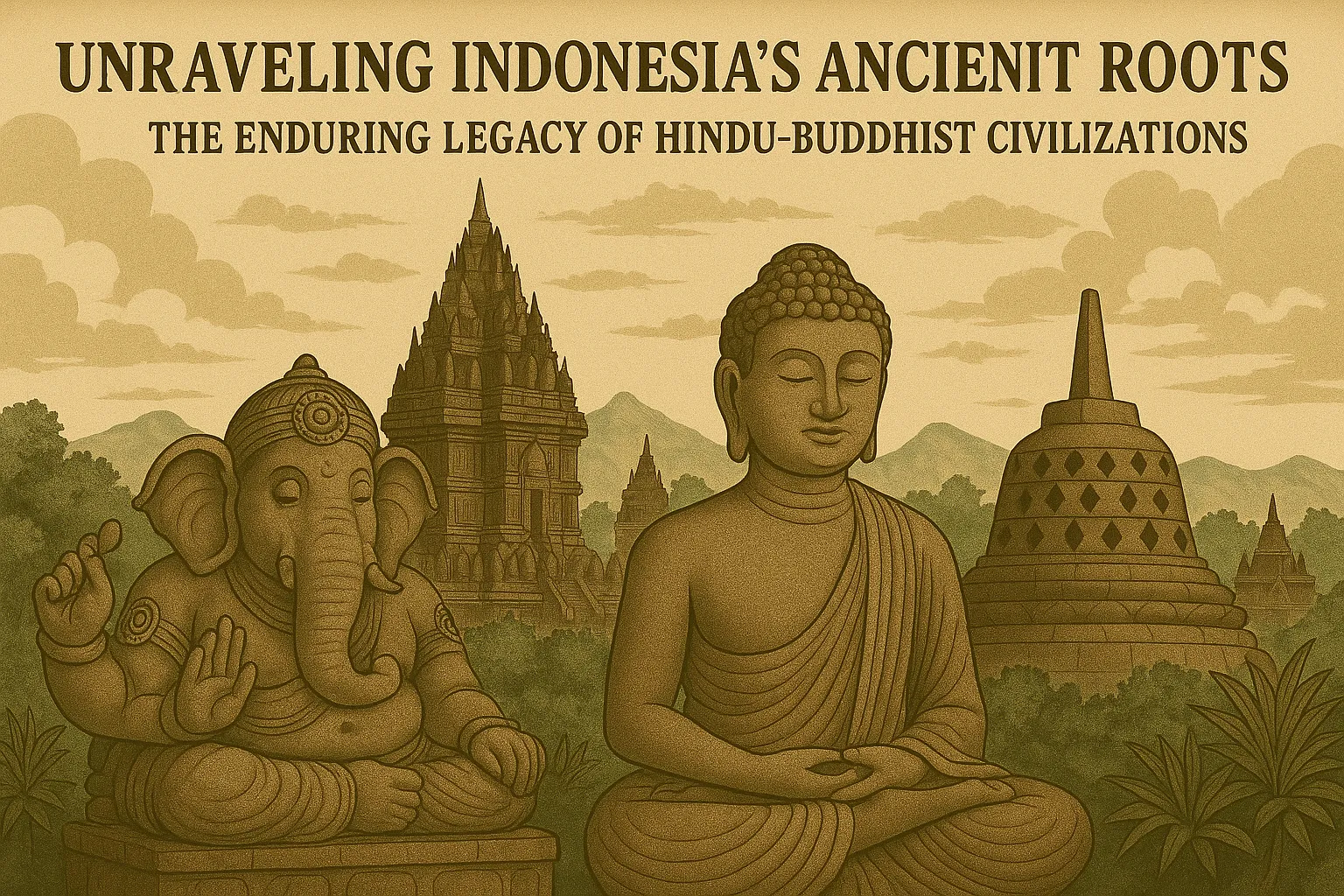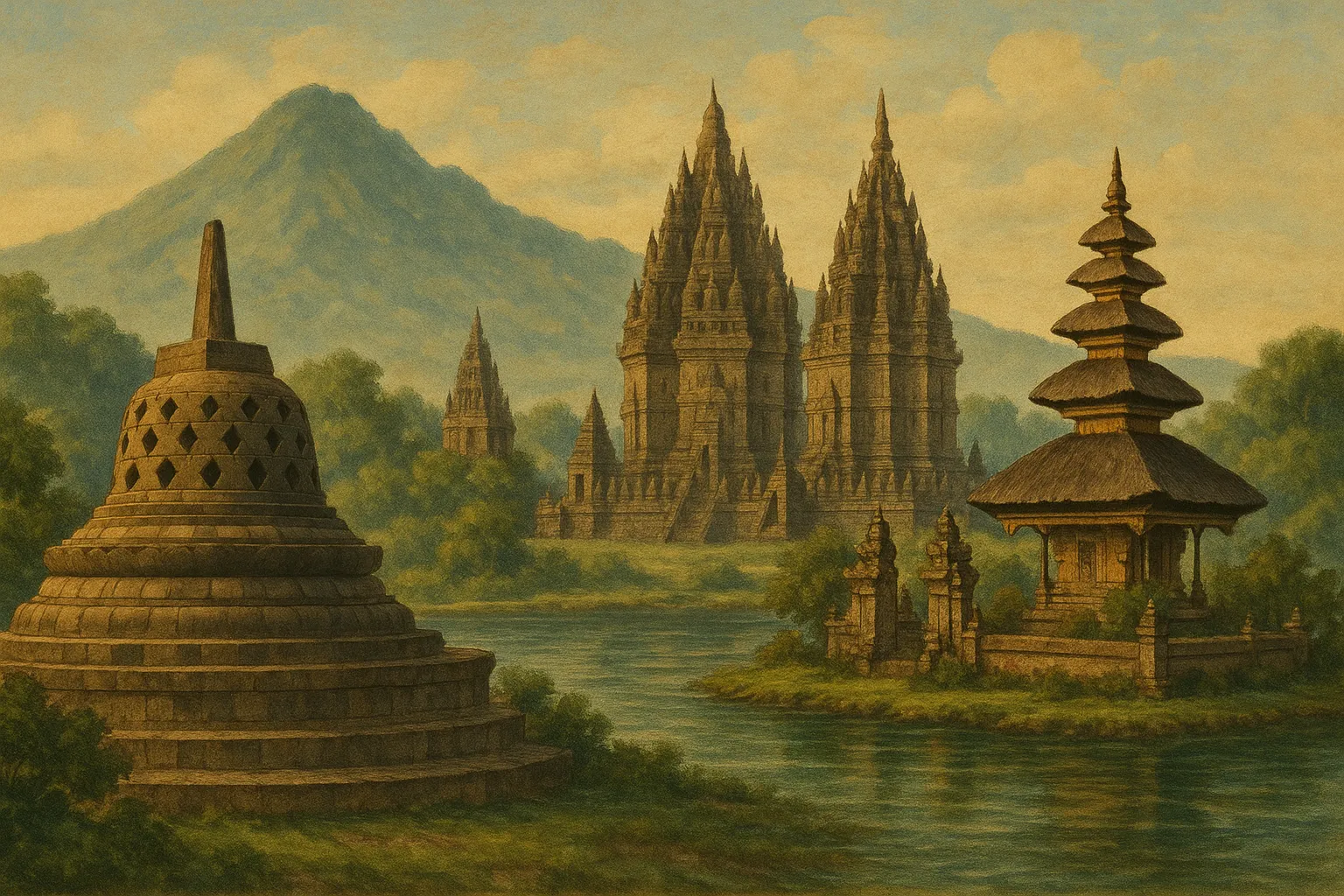Indonesia, a captivating archipelago brimming with natural beauty, is also a treasure trove of complex and harmonious history and culture. From its bustling cities to its tranquil islands, every corner of Nusantara holds a long story of intercultural interactions that have shaped our modern identity. Join us as we explore a pivotal chapter in this narrative: the profound influence of Hindu-Buddhist civilizations.

See Table of Contents
A Meeting of Worlds: India’s Early Impact on the Archipelago
Long before the modern era, Indonesia fostered strong ties with Indian civilizations, primarily through vibrant trade routes established as early as the first century CE. This interaction was more than just an exchange of goods; it was a profound transfer of ideas and beliefs that ultimately gave birth to monumental cultural achievements across the Indonesian archipelago.
Architectural Wonders: Temples That Speak Volumes
One of the most visible testaments to Hindu-Buddhist influence is Indonesia’s magnificent architectural heritage. Imagine gazing upon the majestic cluster of Gedong Sanga temples, standing gracefully amidst the Ungaran mountains in Central Java. These temples were erected during the early period of Hindu influence in Indonesia.
Beyond Gedong Sanga, countless other historical relics can be found across various regions of Indonesia. For instance, the Prambanan and Dieng Temples are breathtaking examples of Hindu-inspired architecture, while Borobudur and Kalasan Temples stand as enduring symbols of Buddhist grandeur in Nusantara. These temples served not only as places of worship but also as invaluable centers of culture and art.

Unpacking the Theories: How Hindu-Buddhism Arrived in Indonesia
How did this powerful Hindu-Buddhist influence actually arrive and flourish in Indonesia? Historians have proposed several fascinating theories:
The Sudra Theory
This theory suggests that the spread of Hinduism to Indonesia was brought by Indian individuals from the Sudra caste, who were considered outcasts or slaves seeking new lives.
The Vaishya Theory
According to this view, Indian traders belonging to the Vaishya caste sailed to Indonesia and introduced Hinduism through their interactions with local communities.
The Kshatriya Theory
This theory posits that the dissemination occurred due to political turmoil in India. Defeated Kshatriya (warrior) groups fled to Indonesia and subsequently spread Hinduism, possibly even establishing kingdoms.
The Brahmana Theory
It is believed that Brahmins came to Indonesia, perhaps at the invitation of local chiefs interested in Hinduism. This theory emphasizes the Brahmins’ exclusive right to study and understand the sacred Vedas.
The Backflow (Arus Balik) Theory
This theory highlights the active role of the Indonesian people themselves. Educated Nusantara individuals traveled to India to learn Hindu-Buddhism, and upon their return, they became key agents in developing these religions and cultures in their homeland.
Regardless of which theory holds the most weight, one undeniable fact is that extensive trade relations were a crucial catalyst for the arrival of Hindu-Buddhist culture in Indonesia.
A Profound Cultural Transformation Across Society
The influence of Hindu-Buddhism extended far beyond physical structures, deeply permeating various facets of Indonesian life:
Belief Systems
Gradually, the people of Nusantara embraced Hindu and Buddhist faiths, beginning with the elite class of local chiefs and their families. Their indigenous animistic and dynamic beliefs were subsequently influenced.
Governance and Social Structure
Indonesia’s original village-based governance system was transformed by Hindu-Buddhist teachings, leading to the emergence of powerful Hindu-Buddhist kingdoms.
Art and Architecture
Hindu-Buddhist architectural styles assimilated with indigenous Indonesian building techniques, as seen in the design of temples. Reliefs adorning temple walls showcase the strong influence of Hindu-Buddhist art.
Language and Literature
The widespread use of Pallawa script and Sanskrit language on inscriptions serves as clear evidence of this impact. Furthermore, Hindu-Buddhist literary works, such as the epics of Ramayana and Mahabharata, were adapted into traditional shadow puppet (wayang) performances.
Education
Knowledge, especially in literature, language, and law, flourished rapidly until the 15th century, with Brahmins playing a significant role in education.
To this day, these ancient cultures continue to thrive in Indonesia, albeit with evolving interpretations shaped by contemporary times. The acculturation of Indonesian culture with Hindu-Buddhist traditions has forged a complex yet harmonious identity, which lives on through our diverse arts, customs, and philosophies.
This exploration offers just a glimpse into the rich tapestry of Indonesia’s history and culture. To delve deeper into how various civilizations, including Chinese heritage, the spread of Islam through Arab traders, and European colonization by the Dutch, have shaped the unique identity of Indonesia, we invite you to explore our comprehensive pillar content on Indonesia Overview: Culture and History.
Source Reference: This blog post is based on key insights from the academic paper “PENGARUH HINDU, BUDA DAN ISLAM TERHADAP KEBUDAYAAN INDONESIA” by Rachmat Panca Putera. You can access the full paper here: ResearchGate – PENGARUH HINDU, BUDA DAN ISLAM TERHADAP KEBUDAYAAN INDONESIA
